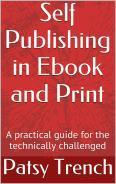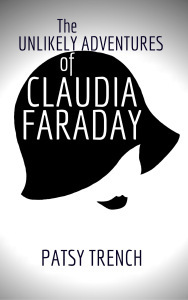Patsy Trench's Blog, page 10
October 23, 2015
The Oldie workshop
~~~~~~~~~
If you are deciding to self publish it is important to arm yourself with as much information on the process as possible from the start. Even if you intend to hand over much of it to other people you need to know exactly what it is you are asking them to do. The better armed you are the less likely you will fall under the spell of the sharks (excuse the mixed metaphor).
Suggestions and recommendations for reputable service providers are below.
The pros of self publishing:
You get to control everything: what kind of book you write, its length, the look of it, the cover, when you are ready to publish, how it is priced and marketed.
You get to keep a good percentage of the royalties yourself: with Amazon it’s 70% for ebooks, in most countries.
If you are not aiming at a mass market then marketing need not be too much of a headache.
The cons of self publishing:
You get to control everything: with no necessary prior experience of publishing you are turning yourself, an individual, into a publisher. You are taking on the work of an experienced team of professionals.
Marketing for self publishers is a challenge. Without a publishing house behind you you are less likely to be reviewed or interviewed in the national newspapers, or to be able to sell your book in major bookshops. (Though neither of these is impossible.)
1) What does self publishing involve?
Write your book. Rewrite it. When it is as good as it could possibly be
Find an editor. (Suggestions below.) This is crucial for all writers, no matter how experienced or talented. Hunt around to find the right editor, who understands the genre you are writing in and respects your style without wanting to rewrite your book. This could be the biggest financial outlay in the whole process (it was for me) but it is worth it.
Have the book proofread. An editor is not necessarily a proofreader, so it’s important to find someone – a close-eyed friend is fine – to read your book and spot the typos. There are bound to be some no matter how many times you checked.
Choose a cover. Unless you are an experienced graphic designer it’s best to hand this to a professional. Print and ebooks have different requirements although both will appear on online retail sites in ‘thumbnail’ size, so make sure the wording is legible.
Write the blurb. Online retailers usually ask for a short description of your book (up to 400 characters) and a long one (up to 4000 characters). This is a selling tool – along with the cover it could be the difference between someone deciding to buy your book or not. Basic guidelines are:
i) Write in the third person present tense.
ii) Don’t try to tell the whole story.
iii) Write in the style the book is written in. (ie Comic if your book is comic, punchy if your book is likewise, etc.)
iv) Including extracts from reviews is fine.
As with the book cover, it’s a good idea to spend time in a bookshop looking at books and analysing why some make you want to pick them up and read them and some don’t.
Create your book interior (paperback): you may want to outsource this too (although it is not difficult to do yourself). It is useful to use a published book you like the look of as a template, and copy the design. You can choose your own font and font size, page (trim) size, margins and chapter layout. Alternatively you can buy ready-formatted templates from the likes of The Book Designer: http://www.bookdesigntemplates.com/
Convert your manuscript into ebook form: this basically involves removing hidden codes embedded in your word processor and creating internal links. Click here for details.
Submit your book. There are currently two main options:
AMAZON. https://kdp.amazon.com Whatever you think of their business practices they have opened up the self publishing business and made it possible and simple for independent writers to upload their books onto their site. Submission is free: they provide you with their own form of ISBN. The submission process is extremely simple, just follow their clear instructions.
Amazon have a print ‘arm’ called CREATESPACE: www.createspace.com / Again this is free and easy to understand.
Amazon is for Kindle ebook only of course. For other e-devices use
SMASHWORDS. www.smashwords.com Again the submission is simple, and free, and they will convert your Word manuscript into the correct formats for Kobo, Nook, Apple and so forth.
2) INGRAM SPARK. www.ingramspark.com/ Ingram have been around for centuries but only recently opened up to make it easy for self publishers to submit their books. The advantage over Amazon is a) they are not Amazon (bookshops don’t hate them) and b) their global distribution of print books is better. Also c) they offer more print options, such as colour, page size, hardback etc. The disadvantage is the submission process is less customer-friendly and you have to provide your own ISBN. (Of which more later.)
Marketing
This is a whole different ballgame and may not be relevant if you are only planning on distributing your book to family and friends. However if you want a broader reach, first
i) Define your target audience
ii) Try for reviews in family history/memoir magazines, or in the local press
iii) Approach your local independent bookshop and ask if they will stock your book, or even help you host a book launch
iv) Social media is an important part of marketing, including author websites
~~~~~~~~~
2) How can I go about it?
There are three main options:
Do it yourself (apart from editing and cover design).
Get partial help with, for instance, cover and interior design and converting to ebook.
Hand the whole thing over to a service provider. There are things professionals can do that we can’t. But BE VERY CAREFUL who you deal with and make sure you know what you are paying for, and that you hang onto your rights.
~~~~~~~~~
RECOMMENDATIONS
Generally tried and tested, some by me and others by ALLI (The Alliance of Independent Authors).
Cover and/or interior print design:
PYNTO pynto.com A husband and wife team. Can design covers and interiors and create websites. Very friendly people to deal with.
Jane Dixon-Smith: www.jdsmith-design.com Cover and interior design.
Cathy Helms: www.avalongraphics.org/books.html
Jessica Bell: www.jessicabellauthor.com/book-cover-design-services.html
designforwriters.com
www.99designs.co.uk Your cover remit is ‘put out to tender’ to a number of designers who are invited to submit their designs, and you choose your favourite. The more you pay (from £189 up) the more designers you will attract. This has the advantage of you being able to choose between several completely different approaches.
Rebecca Lawston: www.lawstondesign.com/index.html
Editors
The following are recommended by ALLI.
Averill Buchanan: www.averillbuchanan.com/
Katherine D’Souza: www.katharinedsouza.co.uk/
Sally Vince: www.editorsal.com/
Alison Shakespeare: http://shakspeareeditorial.org/
Cornerstonses and The Literary Consultancy are manuscript assessors and they also offer some editing services.
Cornerstones: http://cornerstones.co.uk
The Literary Consultancy: https://literaryconsultancy.co.uk
Full help
The following two companies are consistently held to be efficient, honest and trustworthy:
MATADOR: troubador.co.uk/matador.asp
SILVERWOOD www.silverwoodbooks.co.uk/packages
You can buy in part service from them (ebook conversion only for instance) or full service.
Ebook conversion
Sarah Houldcroft: http://www.vaforauthors.com/
Leila Dewji : http://www.iamselfpublishing.com/
If you do decide to do the whole thing yourself take a look at my self publishing pages. Or buy my book (available on Amazon at £1.99)!
Self publishing may seem daunting, and is, but the more research you do the more sense it makes. It is a fantastic resource for memoir writers.
If you are serious about it you might consider joining The Alliance of Independent Authors. If you click on the logo on the sidebar of this page it will take you directly to their site.
GOOD LUCK with your publishing enterprise. And If you have any other specific questions on things I haven’t covered please email me at
patsytrench@gmail.com
Recommended books
Choosing a Self Publishing Service, published by ALLI


October 7, 2015
The Unlikely Adventures of Claudia Faraday
(Names have been changed to protect reputations)
Now available as an ebook on amazon.co.uk, amazon.com and amazon.com.au, Barnes & Noble, Kobo and Inktera
The paperback version will follow soon.
CLICK TO READ A SAMPLE: CHAPTER 1


September 15, 2015
Casting your characters
He was a real person from several centuries ago: an estate manager who fell in love with and married the boss’ daughter, resulting in her disinheritance from the family fortune. She couldn’t figure out what he looked like, how he spoke, walked, and so on. So I asked her when she sells the film rights to this as-yet-unwritten masterpiece, who she would cast in the role, which set us off into a flurry of googling thirty-/forty-something actors who could play both tough and tender, with a bit of the Four Musketeers thrown in.
My first suggestion, Tom Hiddleston, was rejected because he looked too ‘nice’, though I tried in vain to explain to my friend that his Coriolanus was far from ‘nice’. (That was just as well as I rather fancied him to play George Matcham, the tall, rich and elegant gentleman who appeared in my book.)
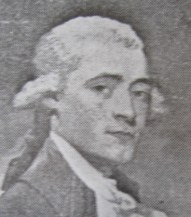
George Matcham

Tom Hiddleston (Huffingtonpost.com)
That got me thinking about who might play Claudia in my as-yet-to-be-published novel The Unlikely Adventures of … People from Glenda Jackson on complain still about the lack of parts for mature actresses, but I struggled to think of a suitable one. Vanessa Redgrave (a tad too old), Maggie Smith (too mannered), Judi Dench (perfect, if she was younger), Charlotte Rampling (at a pinch). I ended up eventually with Penelope Wilton.
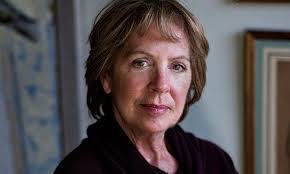
Penelope Wilton (theguardian.com)
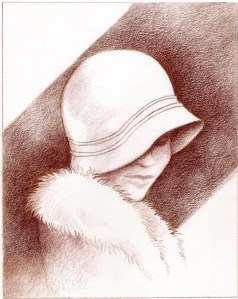
Claudia Faraday (sketch by Anna de Polnay)
This is not just a fun game, it’s a useful exercise for writers. If you can see your character, hear what she/he sounds like, it might just help to create him or her in the first place.


August 21, 2015
Our Country’s Good

National Theatre programme
Out of this unusual and remarkable story the playwright Timberlake Wertenbaker crafted a funny and moving play called Our Country’s Good, adapted from Thomas Keneally’s novel The Playmaker and first produced at the Royal Court Theatre back in 1988. Now the National Theatre is giving the play a welcome revival, but maybe it was the vastness of the Olivier stage that dissipated much of the intimacy of the relationships at the heart of the play, or the slow pace of the action (it was a second preview), but somehow the joyful, redemptive play that I remember from all those years ago was not as moving or as funny as I was expecting.
The director has made the unusual decision to cast Afro-Caribbean actors in the roles of Governor Phillip and the witty and elegant Watkin Tench. I am all for colour-blind casting but since this is partly a story of the colonisation of a black country by a white one, in this instance it is just confusing. The aboriginal community is represented by one actor (one more than in the BBC TV series ‘Banished’), who observes, and dances, and eventually speaks his thoughts (in cultured English, another jarring note).

Governor Phillip (wikipedia)
But all power to the actors, and in particular to Jason Hughes (Midsommer Murders) who manages to turn the uptight, slightly humourless Ralph Clark into a warm and interesting human being; and to Lee Ross, who takes on the role of the ‘thespian’ Sideway and makes him both hilarious and totally believable. The music is an unusual (and remarkable) mix of gospel, slave-song and guitar, with just the right mix of didgeridoo – previously recorded in Australia I believe.
~~~~~~~~~~~~~~~~~

(wikipedia)
In preparation for seeing the play I have been re-reading Keneally’s book. He calls it a novel, but more surprisingly he states that ‘All characters in this publication are fictitious and any resemblance to real persons, living or dead is purely coincidental’. However virtually all his characters, from the governor and his bad-tempered deputy Major Robbie Ross to the convicts Robert Sideway and Mary Brennan – who Clark casts in his play and with whom he later had a child – were not only real people but are represented by Keneally pretty accurately.
In his Author’s Note Keneally acknowledges ‘… that in making this fiction he found rich material in such works as ‘The Journal and Letters of Lt Ralph Clark … and David Collins’s An Account of the English Colony in New South Wales’. Out of idle curiosity I glanced through both of these to find that while Clark kept intimate diaries of some of his early years in the colony the relevant period in 1789 is missing. And all Collins has to say about it was: ‘The anniversary of his Majesty’s birth-day … was observed with every distinction in our power; … the detachment of marines fired three vollies, which were followed by twenty-one guns from each of the ships of war in the cove … and in the evening some of the convicts were permitted to perform Farquhar’s comedy of the Recruiting Officer, in a hut fitted up for the occasion. They professed no higher aim than “humbly to excite a smile,” and their efforts to please were not unattended with applause.’ (They did love their double negatives in those days.)
So all power to Thomas Keneally and to Timberlake Wertenbaker for drawing to our attention such a remarkable (and unusual) event in the earliest days of the colony. And to the National Theatre for transporting us temporarily to that remarkable and much-ignored (in this country) continent.
Finally – a note to the programme compilers: Norfolk Island is not off the coast of Tasmania.
August 17, 2015
Self publishing for family historians part 2
DO be clear exactly what you are looking for
DO make sure you hang onto the rights to your book
DO make sure the royalties come straight to you and not through a third party
~~~~~~
SUBMITTING YOUR MANUSCRIPT ONLINE
The online market leader is Amazon/CreateSpace, but there is also Ingram/Spark and Lulu. I have no direct experience of these last two, but I do know that while Amazon/CreateSpace charge nothing to upload your book or to re-upload later amended versions of it, Ingram do charge for both. The advantage of Ingram is that I believe they offer different qualities of, for instance, paper, and the shipping may be cheaper as they have an outlet here in the UK, and in Australia.
CreateSpace is the print arm of Amazon and their website is very user-friendly.
Once you’ve uploaded your title and chosen your dimensions and page colour you will be taken to a Pricing page. You can price your book in US$ and the other currencies will calculated automatically, if you wish. (Or you can adjust this.)
The ISBN is provided free through CreateSpace but not on Ingram. You can buy your own ISBN which then belongs to you no matter who you publish through. CreateSpace also have a forum, or ‘Community’, where you can post queries and with a bit of luck someone will get back to you pretty quickly, especially if you post in the afternoon when America has woken up.
Categories and keywords: we didn’t get to discuss these in the workshop, but they do help to sell books if you get them right. Amazon/CreateSpace offers a selection of categories to choose from, and you can pick your own keywords (up to 7, if I remember correctly).
Ordering copies. With Print on Demand unit costs of printing are very reasonable. My 318-page book costs $4.64 to print out, per copy. There are various shipping options but as a guide, Expedited Shipping (3 weeks or so) costs $7.99. Obviously shipping costs per book are less per item the more you order in one go. You can also order copies to be sent direct to other people, all round the Globe.
DIY:
If you do decide to do it all yourself (and if I can do it anyone can) I have produced a book aimed at the technically challenged, available on Amazon.
~~~~~~~~~~
MARKETING
This may not be a priority for the family historian but it’s worth mentioning.
Social media is an option obviously, but has to be handled carefully (ie no constant hard selling). What is a good idea is to have a website with a recognisable family name as a title as this will lead other family members to you. Mine, named after my ancestress (marymatchampitt.wordpress.com), has introduced me to several distant relatives with interesting tales to tell. It’s also worth considering a website and Facebook page dedicated to your book.
Reviews are also worth going for, especially from family history magazines.
Family Tree: http://family-tree.co.uk/
Who do you think you are?: http://www.whodoyouthinkyouaremagazine.com/
Family Tree Magazine: http://www.familytreemagazine.com/
Your Family Tree Magazine: http://www.yourfamilytreemag.co.uk/
‘Who do you think you are’ magazine also has a feature at the back called ‘My Family Hero’, and they are often looking out for people to fill it.
~~~~~~~
EBOOKS
Why not? It doesn’t cost much to have your manuscript converted into the suitable formats for Kindle, Kobo, Nook and whatever other devices there are out there. For some reason self publishers tend to sell more ebooks than paperbacks. In my case 90% of my sales are ebooks.
FINALLY (almost): An update on cover design
It’s worth taking a look at this site:
http://www.thebookdesigner.com/2015/08/e-book-cover-design-awards-july-2015/
Joel Friedlander is a book cover and interior designer (he also offers page templates). This is the result of a competition where writers submit their covers and he comments on them and chooses winners. It’s useful as you can compare your opinion with his! (And comment if you want to.)
Which reminds me:
USEFUL WEBSITES on self publishing: (or to follow on Twitter)
http://www.thebookdesigner.com
Frances Caballo: http://www.socialmediajustforwriters.com
Joanna Penn: http://www.thecreativepenn.com/
And if you are looking for advice on everything to do with self publishing you could consider joining ALLi (The Alliance of Independent Authors). Click the ALLi logo on my site. Their subscription fees are £75 for a published (self- or otherwise) author. ALLi have also produced some useful books on self publishing such as:
That is really it. Good luck with your various projects, and please email me on patsytrench@gmail.com if you have any queries (or interesting tales about your self publishing experience).
Goodbye!


August 16, 2015
Self publishing for family historians
As promised to the gentle folk at the Society of Genealogists on Saturday’s workshop on self publishing, here are my notes, posted in two parts.
WHERE I am coming from
What I know about self publishing comes from hard-earned experience publishing my book The Worst Country in the World, which after six years of writing (on and off) evolved into a hybrid mix of family history, early colonial Australian history, memoir and novel. For that reason alone I did not attempt to get it traditionally published. (Nor I realise would any publisher want to take on a book that is not likely to be a mass seller.)
Having read up everything I could find on self publishing and sent off for and received quotes that would entail taking out a mortgage, I decided to do everything myself: convert the book into ebook and design the paperback. The only things I paid for were for editing and cover design. (This not necessarily a path I would recommend unless you have plenty of time and endless patience.)

Sketch by Anna de Polnay
WHAT is self publishing?
Self publishing is ideal for family historians for the following reasons:
You get to control everything:
You can write the book you want to write
You can choose exactly how you want it to look
You can spend as much or as little as you want to
It doesn’t matter if you’re only expecting to sell a few copies
Print on Demand (POD), which means your manuscript is stored on some electronic device and only printed out when someone orders it, has revolutionised the publishing business. The unit cost of a book is the same whether you order one copy or five hundred. No book goes out of print, and there is no wastage.
However whether or not you decide to buy in professional services or advice it’s important to have a clear idea of what you are looking for with your book. There are sharks out there who are only too happy to charge a small fortune for not very much indeed.
Having done a lot of asking around two companies cropped up frequently, known to offer an efficient, professional and trustworthy service.
MATADOR: troubador.co.uk/matador.asp
SILVERWOOD www.silverwoodbooks.co.uk/packages
Matador’s charges are (according to Choosing a Self-Publishing Service, published by ALLi)
Setup, including ISBN, barcode, custom cover design: £680
Ebook conversion: £150
Copy edit: £390
Proofread: £340
They do not provide editors, but they do offer marketing and the possibility of getting your book into bookshops (apparently).
SilverWood’s charges are similar, though I’m told they offer a slightly more personal service, and they don’t take on every book.
Also worth considering:
PYNTO: pynto.com
A husband and wife team who offer cover design (at £240), book interior design, setting up of websites, marketing etc.
At the high end of the market:
LIFELINES PRESS: lifelinespress.com
A bespoke, personal service for print books only, offering everything from ghost writing to editing to the end production of a beautiful work of art, printed on paper of your choice, handbound in leather or anything else you choose.
Before you approach any of these companies however:
What you need to think of
EDITING: Every writer needs an editor no matter how experienced or successful they are. There are three main types of editor:
Structural edit – checking for clarity, over-writing, under-writing, repetition, overall structure
Copy editing – line by line checking for grammar, clumsy writing, repetition, clarity
Proof reading – checking for mistakes and typos
There is a certain amount of blurring between these three tasks, but do not expect an editor to proofread your book. It is not his/her job. She/he may correct mistakes if they spot them but it is a different process altogether, and one a sharp-eyed friend might be able to do for you (as she did in my case).
For editors you could do worse than taking a look at the readers at the following manuscript assessment companies:
Cornerstones: http://cornerstones.co.uk/our-editors/
The Literary Consultancy: https://literaryconsultancy.co.uk/editorial/readers-2/
DESIGN of the book
Cover
Interior
Received wisdom says do not try to create your own book cover unless you are an experienced graphic designer or au fait with Photoshop or other graphic software. For cover designers:
https://www.99designs.co.uk UK-based. Your cover remit is ‘put out to tender’ to a number of designers who are invited to submit their designs, and you get to choose your favourite. The more you pay (from £189 up) the more designers you are likely to attract. This has the advantage of being able to choose between several completely different approaches.
http://www.lawstondesign.com/index.html UK-based. Rebecca Lawston, a highly experienced designer who works for several major publishing companies. Her fees start at £500 for print, £150 for ebook, to include branding and marketing material.
http://www.customebookcovers.com/fiction.html US-based. Uses stock images which they manipulate. Charges $150 for print, $100 for ebook, $150 for ebook and print.
http://www.coverbistro.com/ US-based. Uses ‘off-the-peg’ templates at $30, or custom design from $35
pynto.com As above
Matador and SilverWood also offer cover design.
In addition as one helpful participant suggested, it might be worth your while contacting local HE colleges for graphic design students who might offer their services at a modest fee, in return for experience and publicity. (I have yet to check if this is possible.)
BOOK INTERIOR: First, find a book whose layout you like to use as a template. Consider:
SIZE: Of the book; standard non fiction is 6”x9”, fiction 8”x5” (but you can choose what you like). Mine was 6”x9”.
TYPEFACE AND TYPEFACE SIZE: There are specifically recommended fonts. I used Palatino 11 point. It’s not a bad idea to print out a few pages in various typefaces and sizes in your chosen page size to see what it looks like
MARGINS: Mine were quite generous at: top, bottom 1.9cm, inner 2 outer 1.5, gutter .33
CHAPTER TITLE LAYOUT: Centred or left-aligned, upper or lower case, etc.
TRIMMINGS: Drop caps, headers, small caps etc
IMAGES: (photos, maps, family trees) Be aware of copyright: some owners may charge for the use of the image and/or map.
FRONT MATTER : What goes before the main text. This is a matter of choice, but for ebooks certainly it’s good to keep it to a minimum (especially for readers who have downloaded a free sample). Mine are:
Title page
Copyright page
Dedication/quote page.This explained the title of my book
Table of contents. Not essential (except in ebooks, for internal links), but standard for non fiction.
END MATTER : What comes after the main text. Mine are:
Afterword : A dedication to my late aunt, who started me off on my genealogical journey
Acknowledgements
Appendix & chapter notes
Bibliography
Index
Author biog
You can also include reviews, if you have them, or books you’ve already written.
AUTHOR BIOGRAPHY: This is important to readers, so it’s a good idea to make yourself sound interesting and likeable!
Keep it brief
To the point and in the context of the book.
Write in the third person
BLURB: The blurb is crucial – it’s what makes a person read a book or pass on. Mine is on the back cover of my book, and also on my Amazon page.
Again, keep it brief – no more than 200 words
Write in the third person present tense
Remember it is a selling tool not a synopsis, so don’t attempt to tell the whole story
The blurb also acts as a reminder of why you decided to write the book in the first place, and what it was made you think other people might like to read it!
Enough for now. The sun is over the yardarm.
COMING NEXT: DOs and DON’Ts, marketing; ebooks etc.
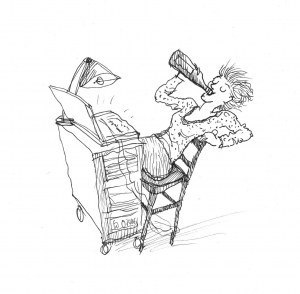
Sketch by Anna de Polnay


June 29, 2015
Writing about what you don’t know: The Light Bulb Moment
If you are a regular historian or biographer you are likely to be writing about people or events or places that interest you and that you already know something about. But if your ancestor was a limner in Victorian times, or a tipstaff in the Middle Ages, or – in my case, a farmer in 18th century New South Wales – you may just have your work cut out. And if the mantra ‘write what you know’ is anything like true then you are about to stumble blind down a long and tortuous alley.
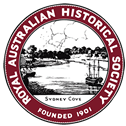 I have received a Heritage Grant from the Royal Australian Historical Society to write about my great grandfather’s exploits as a pioneer farmer in the Moree district in northern New South Wales. As a Londoner I know nothing about farming, not here in the UK and certainly not in 19th century Australia.
I have received a Heritage Grant from the Royal Australian Historical Society to write about my great grandfather’s exploits as a pioneer farmer in the Moree district in northern New South Wales. As a Londoner I know nothing about farming, not here in the UK and certainly not in 19th century Australia.
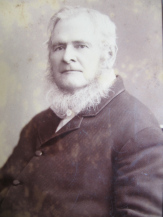
George Matcham Pitt, my great grandfather, subject of my next book
I can see two faint glimmers of light (three including the grant): the reminder from friends that when I complain yet again that this project is ‘completely beyond me’ that is exactly what I said when I was setting out to write my previous family book The Worst Country in the World.
The second comes from reading about the ‘new chums’: early settlers, usually young men migrating from England to ‘take up’ land in the new colony and make their fortunes, cheerfully confessing to having only ‘a vague idea of cattle as heifers, cows, bulls, and oxen, and as beasts that had horns, and made a great bellowing.’
Starting from a point of total ignorance need not be an obstacle. Knowing nothing means you have no preconceptions, either about your subject matter or your readers’ expectations. But if you can’t get interested in your subject then you can’t expect your readers to either.
The process of researching land regulation and droving practices in 1830s New South Wales is like trying to get to grips with a foreign language like Japanese: a sea of hieroglyphs on a page that mean nothing. But with a bit of luck and a lot of persistence, gradually those incomprehensible shapes start to swim into focus: the veil lifts, the light bulb flashes and Eureka: you’re in business.
So, as a way of turning ignorance to advantage I am making notes not just of what I’m learning and the sources I’m learning from, but of those light bulb moments.
My first moment came about with the help of a poem called Saltbush Bill by Australia’s unofficial poet laureate Banjo Paterson.
Now is the law of the Overland that all in the West obey —
A man must cover with travelling sheep a six-mile stage a day;
But this is the law which the drovers make, right easily understood,
They travel their stage where the grass is bad, but they camp where the grass is good,
They camp, and they ravage the squatter’s grass till never a blade remains.
Then they drift away as the white clouds drift on the edge of the saltbush plains…
Saltbush Bill was a drover of remarkable talents. The poem goes on to tell how he managed to extend his stay on a squatter’s land by picking a fight with the jackeroo (who was English, and a new-chum), making it last all day and allowing the jackaroo to win in the end so he could proudly return to the homestead claiming he’d licked the interloper; meanwhile Bill’s sheep had strayed way beyond the legal limit of half a mile from the track and spent the day merrily chomping on the squatter’s lush grass, scattering so far and so wide it took a week to muster them before Bill and his now well-fed mob could be on their way again.

Saltbush Bill by Eric Jolliffe
On a more sober note, Henry Lawson’s The Drover’s Wife tells of the desolate and desperate isolation of a woman living in the sticks with her kids, her husband absent almost all the time, fighting snakes and loneliness, dressing up on Sundays to go for walks along the riverbank with her kids.

The Drover’s Wife by Russell Drysdale (abc.net.au)
These wonderful pieces are an inspiration to this would-be biographer. They demonstrate how it is possible in a few short lines, or pages, to paint infinitely vivid pictures of early colonial life in outback Australia. The message this delivers to me is: when short of inspiration, look to the poets and the authors. Then once you’ve found the spark, and you can convey the excitement of it to the reader, you are well on the way.
Has anyone else out there experienced a light bulb moment?
June 1, 2015
AusNZ Festival part two – Frackman

(Frackmanthemovie.com)
Imagine this:
You decide to quit your life in the city and buy yourself a bit of land in Queensland. You build yourself a shack. Then you notice the bulldozers and you realise that people are digging beneath your property for coal seam gas. You are told you own the ground you live on but not the bit beneath it, and there’s not a thing you can do about it. You are offered compensation of $1,200.
You speak to your neighbours, who’ve been putting up with this for years. You learn their kids are suffering from headaches and nosebleeds. You try to get in touch with the gas company, and with the Queensland government, but all you get is fob-offs, and the odd conversation hanging around your truck, but nothing is resolved. You buy yourself a gas detector and discover there’s gas leaking from the pipes. You hold a gas lighter over the river and the water catches fire. The gas company eventually arrive and carry out their own checks and declare everything is fine.
You take to sneaking into the miners’ depot at night, fixing trackers onto their trucks and monitoring the water into which they are pouring their chemicals. Your own tasting makes you throw up but the sample you send to the lab is mysteriously held up, and proves negative.
You find yourself fronting protest movements and blockades. You travel to America and address the anti-fracking crowds there. Along the way you meet a lovely American girl on the internet but you don’t want her to visit because of the devastation. Eventually she does anyway, but by that time you’ve given up. You’ve lost the fight and sold your property to the gas company for an undisclosed sum.

Dayne Pratzky (news.com.au)
That is the essence of the documentary film ‘Frackman’, which was made over a period of four years in Queensland. It is a very convincing film and the protagonist, Dayne Pratzky, is a compelling, force-of-nature, ‘accidental activist’. You feel angry, and ashamed, you vow to immediately ‘do something’, like divest yourself of any savings that turn out to be invested in the coal seam gas industry.
***
Later on you’re searching on Google and there, under ‘Frackman the Movie: More Fiction than Fact’, you find a riposte from the Energy Resource Information Centre. It’s headed
Frackman facts
and it goes through the film, item by item, repudiating all its claims and backing up the argument with data. It says that ‘A resource licence holder is required to have an access agreement in place before they can lawfully enter the property’. That makes sense. The film acknowledges that unlawful entry of private property is trespass, so the hint is to lock up and not allow anyone access. (Which begs the question, How did they get onto the Frackman’s land in the first place?)
It draws on apparent independent medical examiners who assert ‘a clear link cannot be drawn between the health complaints of some residents in the Tara region and impacts of the local CSG industry on air, water or soil within the community’, and that headaches and nosebleeds are all part and parcel of being a kid. They quote from a test undertaken on 43 wells by the CSIRO that ‘All were found to have some level of emissions, although in all cases these were very low compared to overall production’. And that ‘No evidence of leakage of methane around the outside of well casings was found at any of the wells sampled’.
http://www.energyresourceinformationcentre.org.au/conversation/frackman-facts/
***
So what is a person to think?
My personal instinct is to be very, very wary of coal seam gas mining; that insufficient research was done before they launched in, and that nobody can predict the possible long-term outcome, the effect on the water table and on the already delicate environment. No doubt the Energy Resource Information Centre – who are ‘funded by the natural gas industry, and make no secret of that fact’ – will dismiss the likes of Frackman, and of me, as ignoramuses who are needlessly scared of something we don’t understand. That’s another way of saying ‘If you don’t understand something then keep your mouth shut and your ideas to yourself.’ It’s the sort of thing bankers and financiers might say. It’s how the elite have always kept the ordinary people under control, through ignorance. It’s why people like William Tyndale were burnt at the stake for translating the Bible into English so ordinary people could actually read and understand it.

William Tyndale (Wikipedia)
Quite apart from all that, coal seam gas, or unconventional gas, or any kind of gas come to that, is in the end a fossil fuel and therefore yesterday’s energy source. Surely of all countries in the world Australia, with its endless sunshine and its wild, wild weather, is the best place to be looking forwards for a change and concentrating its energies, so to speak, on developing renewables.
As, indeed, should we in the UK.


May 29, 2015
Australia & New Zealand Festival of Literature & the Arts
Taking place right now, and over the coming weekend. Highlights (for me) include Let’s Talk about Anzac, a discussion with the director and cast of the current production of The One Day of the Year (a terrific production, reviewed on my theatre website at londontheatrevisits.com/blog); The Indigenous Voice, with Kate Grenville and Tony Birch; The Mara Crossing, on migration, and Who Owns Culture? with Gaye Sculthorpe, curator of the current exhibition at the British Museum, Indigenous Australia.
There are films too: Tim Winton’s The Turning is on on this evening and Frackman, ‘an observational documentary following ordinary Queenslanders caught up in a modern day multinational “gas rush” to secure and exploit coal seam gas’, is showing on Saturday evening.
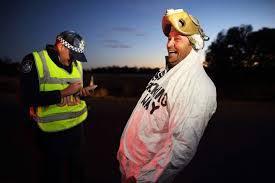
frackmanthemovie.com
Other luminaries appearing include Howard Jacobson and AC Grayling, but unfortunately not Don Watson, whose fascinating book The Bush I am reading right now.
The full programme and booking details can be found here: http://ausnzfestival.com/shows/
The festival is a must for anyone interested in Australia and New Zealand.


April 22, 2015
Crimes and Punishments
My great great great grandparents were transported in the early 1800s for 14 and seven years respectively for the crimes of being in possession of forged banknotes, and for stealing ‘a cloak and other goods to the value of £1.13s.6d from the house of Thomas Cunningham, Gatton, Surrey’.
According to the National Archives the local Assize Courts were ‘where the most serious criminal trials were held twice a year by judges appointed by the monarch’.[2] Since both John Johnson, the receiver of forged goods, and Mary Moore, the cloak-stealer, were tried and convicted at Stafford and Surrey Assizes respectively that gives some impression of the nature of the ‘serious crimes’ that led to transportation in the early 19th century.
We have all heard of people being transported for the crime of stealing a handkerchief, though I gather most of them were not first-time offenders. (And handkerchiefs in those days were not the plain old cotton things some people use now: they were often made of silk and could be worth as much as 4s), but I can’t help noticing further up the page where my ancestress Mary Moore was ‘committed of Felony’ other felons convicted of crimes such as stealing a sheep priced £4, or goods valued at £2.12, are to ‘be severally hanged by the neck until they are dead’.
Another ancestor (my step great x three grandfather, an Irishman named Robert Aull) was given a death sentence, commuted to transportation, for ‘uttering forged stamps’. (‘Uttering’ means knowingly being in possession of stolen or forged goods with the intention of passing them on.) Margaret Catchpole, one of Australia’s most famous convicts, who featured in my first book The Worst Country in the World, was given two death sentences, for horse stealing and then for breaking out of gaol, commuted again to transportation because people stood up for her good character.
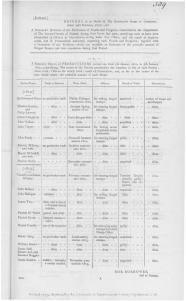
Robert Aul [sic] conviction, Londonderry Assizes 1813
Now I need to find out why John Johnson, a potter from Staffordshire, was apprehended on the streets of Leek with three forged banknotes on his person, and why his wife-to-be Mary Moore was convicted of stealing from the family she worked for. It’s possible she was intending to sell the goods on, as many people did, to a ‘fence’ – which suggests she had criminal contacts – or, more likely, she was planning to pawn them. Local newspapers are my only hope.
But meanwhile, back in Australia …


